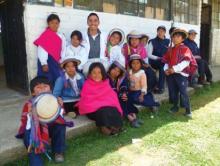Dr. Danesh Modi, and his wife, Dr. Valerie Bonica, participated in a month-long global health rotation that sent them to the Andes Mountains of Ecuador in January 2011. Dr. Modi primarily worked at two hospitals in the city of Riobamba, while Dr. Bonica saw patients in their homes or in several small clinics located in villages throughout a rural region known as Cacha.
"We had wanted to do this for a while," before graduating residency and entering the world of medical practice in the United States, Dr. Modi said in an interview. Both graduates of the University of Medicine and Dentistry of New Jersey School of Osteopathic Medicine, Stratford, they were able to complete their last months of residency during their time in Ecuador, where they put their Spanish fluency to the test. Here, Dr. Modi shares their experiences.
Describe the medical settings in Ecuador.
Riobamba is a small city, built in Spanish colonial times, while Cacha is an indigenous community, where the people work generally in subsistence agriculture and rarely visit the town. Very few have cars, and they live in mud or adobe houses in very small communities.
There are a handful of hospitals in Riobamba. We worked at two of them. One was a social security hospital (El Instituto Ecuatoriano de Seguridad Social) and the other was a free hospital, where anyone could walk in and receive free medical care.
The social security hospital is fully privatized, and one cannot receive care there unless you have a social security card. Individuals who have these cards pay for them on a monthly basis. There are no set benefits, but they pay about a third of their salary every month, which gives them the right to be seen at this hospital.
Were there substantial differences between the hospitals?
There was a big dichotomy, as you might expect. The social security hospital has both inpatient and outpatient care. The people who are able to obtain social security cards, in general, are those who are more affluent.
In the free hospital – called the Hospital General Docente – there were six beds to a room, with no curtains, so there was really no privacy for these patients.
How was medicine practiced differently in Ecuador?
Overall, there was a much greater reliance on the clinical exam. The Ecuadorian physicians, from what we saw, performed a more-thorough physical exam than we do in the U.S. For example, in the U.S., an echocardiogram is a relatively common diagnostic study, but in Riobamba, a cardiac ultrasound is not available, even in the social security hospital. In fact, if deemed necessary, patients must be referred to one of the big cities to have an echocardiogram and it’s also very expensive.
Even a plain radiograph required explicit indications and was not often performed. We had to decide whether we really needed a chest x-ray and if it would really change our management. When radiographs were performed, we had to hold the films up to the window to read them, which made it difficult to compare them to prior studies.
What types of conditions did the patients have?
Many of the conditions among the people in the rural villages of Cacha stemmed from poverty and were related to poor sanitation, the lack of clean drinking water, poor diet, and poor personal hygiene. The people live at a high altitude in a relatively cold climate, yet we were surprised to see that many did not wear shoes. We were told that this was part of their culture and not necessarily because people could not afford to buy shoes. The indigenous peoples’ culture and values date back thousands of years, and their beliefs are often incongruous with the beliefs and knowledge of Western medicine.
These communities were fairly isolated, and the people for the most part were self-sufficient, farming their own crops and tending their own livestock. They rarely went down to the town and often by the time they presented to the hospital or to one of the public health clinics, they were quite sick.
We saw many parasitic infections from the lack of clean drinking water, as well as other infectious diseases that you rarely see in the U.S.
The cases we saw included amebiasis, thyroid disease (a common problem because noniodized salt is cheaper), alcoholic cirrhosis, blindness from uncontrolled hypertension and diabetes, GI bleeds, tuberculosis, interstitial lung disease (in miners and agricultural workers), rheumatic heart disease, and influenza.

